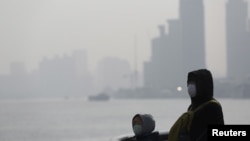Environmental pollution kills more than 1 in 4 children under the age of five every year - that's 1.7 million children worldwide.
The World Health Organization warns these child deaths will increase dramatically if action is not taken to reduce environmental risks.
WHO examines the impact of harmful environments on children’s health and offers solutions in two new studies, “Inheriting a Sustainable World: Atlas on Children’s Health and the Environment” and a companion report, “Don’t pollute my future! The impact of the environment on children’s health.”
The authors agree that air pollution is the biggest killer and is responsible for 6.5 million premature deaths every year, including nearly 600,000 deaths among children under age five.
Margaret Chan, WHO director-general, notes that young children are most at risk of dying from a polluted environment because of “their developing organs and immune systems, and smaller bodies and airways.”
While most of these child deaths occur in developing countries, Maria Neira, WHO Director, Department of Public Health, Environmental and Social Determinants of Health told VOA that air pollution was a big leveler between rich and poor countries.
“You can be a very rich child, your parents very rich, but living in a place, in a city, which is very polluted-then there is very little you can do because we all need to breathe.
“So, even if you are rich or poor, you still need to breathe and this is very pernicious. Air pollution is everywhere,” she said.
WHO reports the most common causes of death among children aged one month to five years are diarrhea, malaria and pneumonia.
“These are very much affected by air pollution, water and sanitation, which is inadequate, but also the disease vectors, mosquitos around the house and the community,” said Annette Pruss-Ustun, scientist in WHO's Public Health and Environmental Department.
“These are mainly a problem in low-and-middle-income countries except air pollution, which also children in high income countries are affected by,” she said. “But, there they do not die from it because the health care system takes care of them in time.”
WHO reports actions including those of providing safe water and sanitation, limiting exposure to hazardous chemicals, and improving waste management can prevent many environmentally induced deaths.
Maria Neira cited access to clean fuels as one of the most important interventions.
“Almost half of the world population is using dirty fuels for cooking, heating, and lighting at home. And, this is affecting very much mothers who are staying and cooking at home, but the children who are around mothers—they are exposed as well.”
Neira said that providing clean energy and clean fuels to households will have enormous benefits for the health of the children and others as well.
Besides these decades-old traditional threats, she warned that emerging environmental hazards, such as electronic or e-waste were posing great dangers for children.
”Most of our old computers and electronic material will end up in some place in the African continent where then you put a group of moms to remove certain pieces of that material, particularly heavy metals to recycle them for making some dollars,” she said. “The problem is that the mothers will go there with their own children.”
She added that exposing children to toxins can lead to reduced intelligence, attention deficits, lung damage and cancer.
Electronic and electrical waste is forecast to increase by 19% between 2014 and 2018, to 50 million metric tons by 2018.
WHO warns that temperature rise due to climate change and rising levels of carbon dioxide will increase pollen in the atmosphere, resulting in higher rates of asthma in children
The health agency is calling for greater action to reduce indoor and outdoor air pollution, second-hand smoke, unsafe water, sanitation and inadequate hygiene.
WHO warns harmful exposures to environmental pollutants can start in the mother’s womb and can lead to “increased risk of chronic respiratory diseases, asthma, heart disease, stroke and cancer” later in life.








